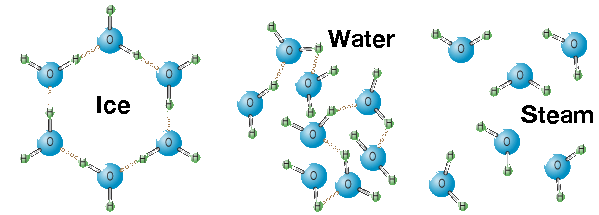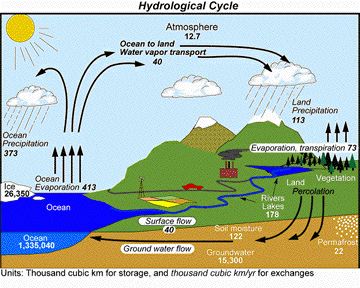|
© Eric R. Pianka Water molecules can exist in three different forms: ice, liquid water, and steam depending on temperature. Hydrogen bonds are strongest at subzero temperatures when they hold six oxygen atoms in a tight hexagonal molecule of ice (leftmost below). In its liquid form (middle below) oxygen atoms are loosely linked in chains, whereas at temperature above 100o C, they are separated in steam (right plot below).  As they are cooled, aggregates of most other substances increase monotonically in density becoming progressively heavier -- the colder they are, the more tightly packed their molecules become. But water possesses a peculiar physical feature: ice expands, so it is lighter than liquid water (i. e., ice floats). When water trapped in rock crevices freezes, it breaks rocks (and pipes). Like most other substances, water moves through a dynamic biogeochemical cycle called the hydrological cycle involving evaporation, transpiration, condensation, freezing, melting, precipitation and runoff. For example, when water vapor in the atmosphere is cooled, it reaches its dewpoint and condenses to form precipitation in the form of rain, ice or snow, which falls to the ground where some runs off down creeks and rivers into lakes and the oceans. A portion of this falling precipitation sinks into the ground and replenishes soil and groundwater supplies. The sun's heat causes evaporation which converts liquid water to vapor, replenishing water in the atmosphere. In addition, plants and animals release water back to the atmosphere via evaporation and also by transpiration (the sum of these two processes is called evapotranspiration). The rates at which water molecules move between and among these various compartments constitutes the hydrologic cycle. Human activities have altered this cycle as we divert flowing waters to agriculture and pump out deep groundwater, even exhausting some underground aquifers. Global warming is now melting ice and glaciers and raising sea levels.  Water is vital to all known life forms, that is, all those on planet Earth. It is so integral to life as we know it that many biologists cannot even envision life without water (although that might be possible). Indeed, the physical properties of water dictate critical thermal limits for living systems. Humans have reduced or even stopped the flow of major rivers by diverting water to fields of crops or to city water supplies. We have also polluted almost all the world's freshwater ecosystems with our wastes. Some rivers are so polluted that fish cannot even live in them. As a result, freshwater fish and amphibians are some of the world's most endangered species. Before humans usurped so much fresh water, creeks and rivers flowed and remained clean due to constant entry of fresh clean rainwater. Lakes and the oceans were also free of pollution. Estuarine waters like the Gulf of Mexico constantly flushed out by clean fresh river water entering them. All fresh water is now polluted both with human waste and fertilizer. We intercept vast amounts of water for agriculture and apply much too much nitrogenous fertilizer which flows off as waste. The Gulf of Mexico is under siege now because we take so much water before it gets to the gulf, as a result it has become much too saline, and, to top off this insult to injury, nitrogen has increased to toxic levels. Gulf fisheries are in great trouble even without the great BP oil spill!! In one sci-fi story, an alien refers to humans as "ugly bags of mostly water" -- our bodies are about 60-70% water, depending upon how dehydrated we are at any given time. Humans use massive amounts of freshwater to drink, cook, bathe, flush toilets, do laundry, fill swimming pools, irrigate yards and gardens, run flowing fountains, and for recreation. Precious clean water is often wasted, such as when people leave tap water running while washing their hands or brushing their teeth. The personal water consumption of an average American is about 200 gallons per day, but when industrial and energy usage is added in, per capita freshwater usage is more than 2000 gallons/day. People in third world countries use much less water, of course. Most freshwater is claimed or "owned" and there is not enough to go around. Approximately half of the world's population of people do not even have adequate access to clean drinking water. One of the major symptoms of the human overpopulation crisis is shortages of available fresh water. Wars will be fought over water. Links: Watch NASA video on Earth's Water Cycle Watch NASA video on Impact of the Oceans on Climate USGS on water Wikipedia entry on water Wikipedia entry on the water molecule Methane Clathrates See also sewage |